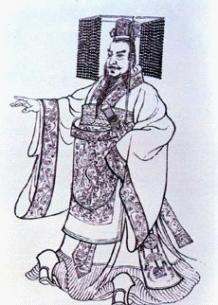hdu-4081 Qin Shi Huang's National Road System(次小生成树)
来源:互联网 发布:西亚斯网络管理中心 编辑:程序博客网 时间:2024/05/17 23:43
题目链接:点击打开链接
Qin Shi Huang's National Road System
Time Limit: 2000/1000 MS (Java/Others) Memory Limit: 32768/32768 K (Java/Others)Total Submission(s): 6405 Accepted Submission(s): 2237
Problem Description
During the Warring States Period of ancient China(476 BC to 221 BC), there were seven kingdoms in China ---- they were Qi, Chu, Yan, Han, Zhao, Wei and Qin. Ying Zheng was the king of the kingdom Qin. Through 9 years of wars, he finally conquered all six other kingdoms and became the first emperor of a unified China in 221 BC. That was Qin dynasty ---- the first imperial dynasty of China(not to be confused with the Qing Dynasty, the last dynasty of China). So Ying Zheng named himself "Qin Shi Huang" because "Shi Huang" means "the first emperor" in Chinese.

Qin Shi Huang undertook gigantic projects, including the first version of the Great Wall of China, the now famous city-sized mausoleum guarded by a life-sized Terracotta Army, and a massive national road system. There is a story about the road system:
There were n cities in China and Qin Shi Huang wanted them all be connected by n-1 roads, in order that he could go to every city from the capital city Xianyang.
Although Qin Shi Huang was a tyrant, he wanted the total length of all roads to be minimum,so that the road system may not cost too many people's life. A daoshi (some kind of monk) named Xu Fu told Qin Shi Huang that he could build a road by magic and that magic road would cost no money and no labor. But Xu Fu could only build ONE magic road for Qin Shi Huang. So Qin Shi Huang had to decide where to build the magic road. Qin Shi Huang wanted the total length of all none magic roads to be as small as possible, but Xu Fu wanted the magic road to benefit as many people as possible ---- So Qin Shi Huang decided that the value of A/B (the ratio of A to B) must be the maximum, which A is the total population of the two cites connected by the magic road, and B is the total length of none magic roads.
Would you help Qin Shi Huang?
A city can be considered as a point, and a road can be considered as a line segment connecting two points.

Qin Shi Huang undertook gigantic projects, including the first version of the Great Wall of China, the now famous city-sized mausoleum guarded by a life-sized Terracotta Army, and a massive national road system. There is a story about the road system:
There were n cities in China and Qin Shi Huang wanted them all be connected by n-1 roads, in order that he could go to every city from the capital city Xianyang.
Although Qin Shi Huang was a tyrant, he wanted the total length of all roads to be minimum,so that the road system may not cost too many people's life. A daoshi (some kind of monk) named Xu Fu told Qin Shi Huang that he could build a road by magic and that magic road would cost no money and no labor. But Xu Fu could only build ONE magic road for Qin Shi Huang. So Qin Shi Huang had to decide where to build the magic road. Qin Shi Huang wanted the total length of all none magic roads to be as small as possible, but Xu Fu wanted the magic road to benefit as many people as possible ---- So Qin Shi Huang decided that the value of A/B (the ratio of A to B) must be the maximum, which A is the total population of the two cites connected by the magic road, and B is the total length of none magic roads.
Would you help Qin Shi Huang?
A city can be considered as a point, and a road can be considered as a line segment connecting two points.
Input
The first line contains an integer t meaning that there are t test cases(t <= 10).
For each test case:
The first line is an integer n meaning that there are n cities(2 < n <= 1000).
Then n lines follow. Each line contains three integers X, Y and P ( 0 <= X, Y <= 1000, 0 < P < 100000). (X, Y) is the coordinate of a city and P is the population of that city.
It is guaranteed that each city has a distinct location.
For each test case:
The first line is an integer n meaning that there are n cities(2 < n <= 1000).
Then n lines follow. Each line contains three integers X, Y and P ( 0 <= X, Y <= 1000, 0 < P < 100000). (X, Y) is the coordinate of a city and P is the population of that city.
It is guaranteed that each city has a distinct location.
Output
For each test case, print a line indicating the above mentioned maximum ratio A/B. The result should be rounded to 2 digits after decimal point.
Sample Input
241 1 201 2 30200 2 80200 1 10031 1 201 2 302 2 40
Sample Output
65.0070.00
题目大意:
有n个城市,秦始皇要修用n-1条路把它们连起来,要求从任一点出发,都可以到达其它的任意点。秦始皇希望这所有n-1条路长度之和最短。然后徐福突然有冒出来,说是他有魔法,可以不用人力、财力就变出其中任意一条路出来。
秦始皇希望徐福能把要修的n-1条路中最长的那条变出来,但是徐福希望能把要求的人力数量最多的那条变出来。对于每条路所需要的人力,是指这条路连接的两个城市的人数之和。
最终,秦始皇给出了一个公式,A/B,A是指要徐福用魔法变出的那条路所需人力, B是指除了徐福变出来的那条之外的所有n-2条路径长度之和,选使得A/B值最大的那条。
分析与总结
为了使的A/B值最大,首先是需要是B尽量要小,所以可先求出n个城市的最小生成树。然后,就是决定要选择那一条用徐福的魔法来变。
因此,可以枚举每一条边,假设最小生成树的值是MinMST, 而枚举的那条边长度是w[i][j], 如果这一条边已经是属于最小生成树上的,那么最终式子的值是A/(MinMST-w[i][j])。如果这一条不属于最小生成树上的, 那么添加上这条边,就会有n条边,那么就会使得有了一个环,为了使得它还是一个生成树,就要删掉环上的一棵树。 为了让生成树尽量少,那么就要删掉除了加入的那条边以外,权值最大的那条路径。 假设删除的那个边的权值是path[i][j], 那么就是A/(MinMST-path[i][j]).
解这题的关键也在于怎样求出次小生成树。
以上引自:点击打开链接
网上有很多关于次小生成树的讲解,这里也不多说了。 直接贴代码。
代码:
#include <iostream>#include <cstdio>#include <cstring>#include <algorithm>#include <cmath>using namespace std;#define N 1010struct Point{ double x,y;}q[N];double ma[N][N];///ma数组用来保存初始图double p[N],d[N],path[N][N];///p是每个城市的人口,d用来维护当前最短距离,path用来记录最小生成树上两点之间所有路径中的单边最大权值int flag[N],pre[N],n,used[N][N];///flag数组标记当前点是否已经在最小生成树里,pre记录当前点的前驱(因为是无向图,其实也就是一条边的另一个节点)///used[i][j]用来记录边ij有没有在最小生成树上,0是不在,1是在double dis(Point a,Point b){ return sqrt((a.x-b.x)*(a.x-b.x)+(a.y-b.y)*(a.y-b.y));}double prim(){ double ret=0;///最小生成树大小 memset(flag,0,sizeof(flag)); memset(used,0,sizeof(used)); memset(path,0,sizeof(path));///题目边都是大于0的,所以置为0就好 for(int i=1;i<n;i++) { d[i]=ma[0][i]; pre[i]=0; } flag[0]=1; for(int i=0;i<n;i++) { int v=-1; for(int j=0;j<n;j++) if(!flag[j]&&(v==-1||(d[v]>d[j]))) v=j; if(v==-1) break; used[v][pre[v]]=used[pre[v]][v]=1; ret+=d[v]; flag[v]=1; for(int j=0;j<n;j++) { if(flag[j]&&j!=v) path[j][v]=path[v][j]=max(path[pre[v]][j],d[v]); if(!flag[j]&&d[j]>ma[v][j]) { d[j]=ma[v][j]; pre[j]=v; } } } return ret;}int main(){ int T; scanf("%d",&T); while(T--) { scanf("%d",&n); for(int i=0;i<n;i++) scanf("%lf %lf %lf",&q[i].x,&q[i].y,&p[i]); for(int i=0;i<n;i++) for(int j=0;j<n;j++) if(i!=j) ma[i][j]=dis(q[i],q[j]); double ret=prim(); double ans=-(1<<30); for(int i=0;i<n;i++) { for(int j=0;j<n;j++) { if(i==j) continue; if(used[i][j]) ans=max(ans,(p[i]+p[j])/(ret-ma[i][j])); else ans=max(ans,(p[i]+p[j])/(ret-path[i][j])); } } printf("%.2lf\n",ans); } return 0;} 0 0
- HDU 4081 Qin Shi Huang's National Road System (枚举次小生成树)
- HDU-#4081 Qin Shi Huang's National Road System(次小生成树变形)
- hdu 4081 Qin Shi Huang's National Road System(次小生成树)
- HDU-4081-Qin Shi Huang's National Road System(次小生成树)
- hdu-4081 Qin Shi Huang's National Road System(次小生成树)
- HDU-4081-Qin Shi Huang's National Road System (次小生成树)
- HDU 4081 Qin Shi Huang's National Road System(次小生成树变形)
- HDU 4081 Qin Shi Huang's National Road System(次小生成树-Kruskal)
- HDU 4081 Qin Shi Huang's National Road System (2011北京-次小生成树)
- HDU 4081 Qin Shi Huang's National Road System (次小生成树)
- HDU 4081 Qin Shi Huang's National Road System (次小生成树算法)
- hdu 4081 Qin Shi Huang's National Road System(次小生成树)
- hdu 4081 Qin Shi Huang's National Road System(次小生成树变形)
- hdu 4081 Qin Shi Huang's National Road System(次小生成树变形)
- hdu 4081 Qin Shi Huang's National Road System (次小生成树的变形)
- HDU 4081 Qin Shi Huang's National Road System 最小/次小生成树的性质
- HDU 4081 Qin Shi Huang's National Road System (次小生成树)
- 次小生成树学习小记 Hdu 4081 Qin Shi Huang's National Road System (模板)
- ASP.NET运行机制原理
- NP-Hard问题和NP-Complete问题
- NSURLSession学习笔记(二)Session Task
- bzoj1941: [Sdoi2010]Hide and Seek
- 大话算法-快排
- hdu-4081 Qin Shi Huang's National Road System(次小生成树)
- 动画
- Redis(1)Redis介绍
- POJ 1251 Jungle Roads(最小生成树)
- 使用密码登陆Amazon EC2而不是私有密钥
- Jaxp解析XML的基本方法
- 【WG面试算法】由两个栈组成的队列
- margin-top导致子标签绑架父标签问题
- 机械臂-可操作性(manipulability)


